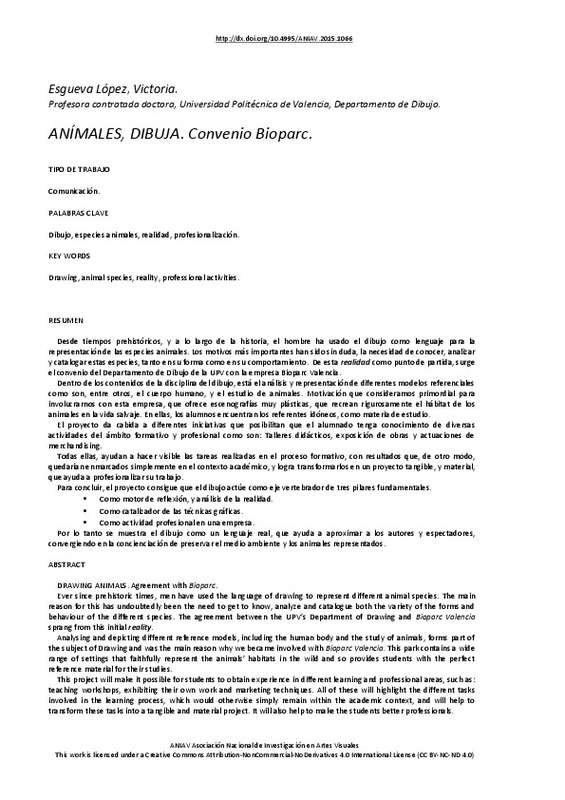JavaScript is disabled for your browser. Some features of this site may not work without it.
Buscar en RiuNet
Listar
Mi cuenta
Estadísticas
Ayuda RiuNet
Admin. UPV
ANÍMALES, DIBUJA. Convenio Bioparc
Mostrar el registro sencillo del ítem
Ficheros en el ítem
| dc.contributor.author | Esgueva López, María Victoria
|
es_ES |
| dc.date.accessioned | 2018-02-13T11:43:25Z | |
| dc.date.available | 2018-02-13T11:43:25Z | |
| dc.date.issued | 2015-11-26 | |
| dc.identifier.isbn | 9788490483411 | |
| dc.identifier.uri | http://hdl.handle.net/10251/97817 | |
| dc.description.abstract | [EN] DRAWING ANIMALS. Agreement with Bioparc. Ever since prehistoric times, men have used the language of drawing to represent different animal species. The main reason for this has undoubtedly been the need to get to know, analyze and catalogue both the variety of the forms and behaviour of the different species. The agreement between the UPV’s Department of Drawing and Bioparc Valencia sprang from this initial reality. Analysing and depicting different reference models, including the human body and the study of animals, forms part of the subject of Drawing and was the main reason why we became involved with Bioparc(Valencia. This park contains a wide range of settings that faithfully represent the animals’ habitats in the wild and so provides students with the perfect reference material for their studies. This project will make it possible for students to obtain experience in different learning and professional areas, such as: teaching workshops, exhibiting their own work and marketing techniques. All of these will highlight the different tasks involved in the learning process, which would otherwise simply remain within the academic context, and will help to transform these tasks into a tangible and material project. It will also help to make the students better professionals. To sum up, the aim of this project is to let Drawing be seen as the foundation of three fundamental pillars: • As a motive for reflecting on and analyzing reality. • As a catalyst of graphic techniques. • As part of the professional activities of a business company. Drawing will therefore be shown to be a real language in its own right and one that not only brings artists and public together, but also makes them aware of the importance of protecting the environment and preserving the world’s remaining wild life. | es_ES |
| dc.description.abstract | [ES] Desde tiempos prehistóricos, y a lo largo de la historia, el hombre ha usado el dibujo como lenguaje para la representación de las especies animales. Los motivos más importantes han sido sin duda, la necesidad de conocer, analizar y catalogar estas especies, tanto en su forma como en su comportamiento. De esta realidad como punto de partida, surge el convenio del Departamento de Dibujo de la UPV con la empresa Bioparc Valencia. Dentro de los contenidos de la disciplina del dibujo, está el análisis y representación de diferentes modelos referenciales como son, entre otros, el cuerpo humano, y el estudio de animales. Motivación que consideramos primordial para involucrarnos con esta empresa, que ofrece escenografías muy plásticas, que recrean rigurosamente el hábitat de los animales en la vida salvaje. En ellas, los alumnos encuentran los referentes idóneos, como materia de estudio. El proyecto da cabida a diferentes iniciativas que posibilitan que el alumnado tenga conocimiento de diversas actividades del ámbito formativo y profesional como son: Talleres didácticos, exposición de obras y actuaciones de merchandising. Todas ellas, ayudan a hacer visible las tareas realizadas en el proceso formativo, con resultados que, de otro modo, quedarían enmarcados simplemente en el contexto académico, y logra transformarlos en un proyecto tangible, y material, que ayuda a profesionalizar su trabajo. Para concluir, el proyecto consigue que el dibujo actúe como eje vertebrador de tres pilares fundamentales. - Como motor de reflexión, y análisis de la realidad. - Como catalizador de las técnicas gráficas. - Como actividad profesional en una empresa. Por lo tanto se muestra el dibujo como un lenguaje real, que ayuda a aproximar a los autores y espectadores, convergiendo en la concienciación de preservar el medio ambiente y los animales representados. | es_ES |
| dc.format.extent | 7 | es_ES |
| dc.language | Español | es_ES |
| dc.publisher | Editorial Universitat Politècnica de València | es_ES |
| dc.relation.ispartof | II CONGRESO INTERNACIONAL DE INVESTIGACIÓN EN ARTE VISUALES | es_ES |
| dc.rights | Reconocimiento - No comercial - Sin obra derivada (by-nc-nd) | es_ES |
| dc.subject | Dibujo | es_ES |
| dc.subject | Especies animales | es_ES |
| dc.subject | Realidad | es_ES |
| dc.subject | Profesionalización | es_ES |
| dc.title | ANÍMALES, DIBUJA. Convenio Bioparc | es_ES |
| dc.type | Capítulo de libro | es_ES |
| dc.type | Comunicación en congreso | es_ES |
| dc.identifier.doi | 10.4995/ANIAV.2015.1066 | |
| dc.rights.accessRights | Abierto | es_ES |
| dc.contributor.affiliation | Universitat Politècnica de València. Centro de Investigación Arte y Entorno - Centre d'Investigació Art i Entorn | es_ES |
| dc.contributor.affiliation | Universitat Politècnica de València. Departamento de Dibujo - Departament de Dibuix | es_ES |
| dc.contributor.affiliation | Universitat Politècnica de València. Facultad de Bellas Artes - Facultat de Belles Arts | es_ES |
| dc.description.bibliographicCitation | Esgueva López, MV. (2015). ANÍMALES, DIBUJA. Convenio Bioparc. En II CONGRESO INTERNACIONAL DE INVESTIGACIÓN EN ARTE VISUALES. Editorial Universitat Politècnica de València. 245-251. https://doi.org/10.4995/ANIAV.2015.1066 | es_ES |
| dc.description.accrualMethod | OCS | es_ES |
| dc.relation.conferencename | II Congreso Internacional de Investigación en Artes Visuales. |< real | virtual >| ANIAV2015 | es_ES |
| dc.relation.conferencedate | July 09-10,2015 | es_ES |
| dc.relation.conferenceplace | Valencia, Spain | es_ES |
| dc.relation.publisherversion | http://ocs.editorial.upv.es/index.php/ANIAV/ANIAV2015/paper/view/1066 | es_ES |
| dc.description.upvformatpinicio | 245 | es_ES |
| dc.description.upvformatpfin | 251 | es_ES |
| dc.type.version | info:eu-repo/semantics/publishedVersion | es_ES |
| dc.relation.pasarela | OCS\1066 | es_ES |








